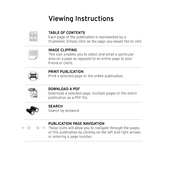Description
TMI239 Cover Story.qxp_Layout 1 07/12/2015 09:26 Page 16
cover story
Where we
are seeing
innovation is
in the
efficiencies in cash management and
trade finance as those in other regions.
Liquidity management can be more
challenging given tax issues, capital and
currency restrictions. The high cost of
conversion between currencies also
reduces the viability of solutions such as
cash pooling, although there are
differences between markets.
role of the
treasury
function in
Latin
America.
Innovation in treasury
While treasurers and their colleagues across
the business may find it difficult to invest
in their enterprise, Latin America continues
to be a region in which innovation is
thriving, albeit in a different way to other
regions.
Where we are seeing innovation is in the
role of the treasury function in Latin
America. Increasingly, treasury is bringing
together different departments, such as
procurement, sales and HR, to align
scorecard metrics and facilitate a more
systematic approach to managing working
capital and supply chain efficiency. This is
also changing the way that customers
adopt new banking solutions, with a wider
range of stakeholders involved, who bring
different experiences and expertise.
Although the sales cycle is inevitably
longer, the result is that solutions are more
closely aligned across the business, and
there is a more integrated approach to
transaction and reporting flows, and
working capital optimisation.
This focus on supply chain integration and
working capital is an issue that has been
discussed by corporations around the world,
but the business imperative is stronger in
Latin America than any other region, firstly
because of low growth rates (which is also
an issue shared by other regions) but
exacerbated by the commodity and
currency issues, higher inflation, and high
cost of borrowing.
To what extent is this driving changes in the way that corporations work with their banks? This enhanced focus on engagement and collaboration which is being driven by treasury is definitely impacting on the way that companies communicate with their banks. Today more than ever before, we are setting up host-to-host connections with our corporate customers i.e., connecting customers’ internal ERP (enterprise resource planning) and/or TMS (treasury management systems) directly with our own systems. This allows an unparalleled level of security, timeliness and automation in the transaction and information flow between Citi and our customers. A related issue in which Latin America is to some extent taking a lead is on how to resolve the dilemma of proprietary versus independent (e.g., ‘fintech’) solutions.
In regions where the potential value of cash management and trade finance services (for example) is higher, the relationship or balance between the two can be uneasy. In Latin America, where the total value available to providers of financial technology solutions has fallen, there would seem to be greater appetite for collaboration and delivering value to customers through the most appropriate means for their business. Is this your experience at Citi? Absolutely.
In addition to delivering our own solutions, we recognise that a great deal of innovation is taking place outside the bank, particularly in the development of supply chain portals and marketplaces. Reprinted from TMI | www.Treasury-Management.com We are highly respectful of these developments and recognise the value that they offer to the consumer and corporate communities; therefore, rather than trying to replicate these innovations, we are embedding our solutions into these emerging platforms to increase convenience and access. The industry leaders in these fields are very often our customers, so by supporting and facilitating their success, there is further value to our business. What about mobile solutions? We are hearing a great deal about the potential for mobile solutions in other regions such as Asia and Africa, initially in the B2C space and expanding into B2B. To what extent are these developments taking shape in Latin America? Although innovation is a key theme in Latin America to support corporate efficiency and cost objectives, we are seeing less focus on mobile solutions than in some other markets.
In the B2B space, mobile banking is popular as a means for achieving convenient access to bank account and transaction information. As a payments channel, however, there is a lot of expectation but mobile payments are not yet having a major impact in the B2B space. With no immediate signs that commodity and currency values, and therefore growth in the region, are likely to recover, how do you expect current trends to evolve over the coming year or two? The current situation is likely to continue over the medium term, with ongoing commodity, currency, tax and regulatory volatility, all of which pose challenges for corporations and banks doing business in the region. While there may be some normalisation, there is also the potential for further currency devaluation.
Therefore, treasury needs to remain aware and adaptable, just as it has proved to be since the 2008-9 crisis. The integration we are seeing across the business, particularly in the order-to-cash cycle, is likely to continue further as companies seek to reduce their working capital levels. Banks such as Citi have an important role to play through instruments to extend supplier terms without compromising the supply chain, and tools to accelerate collections.
I .
To what extent is this driving changes in the way that corporations work with their banks? This enhanced focus on engagement and collaboration which is being driven by treasury is definitely impacting on the way that companies communicate with their banks. Today more than ever before, we are setting up host-to-host connections with our corporate customers i.e., connecting customers’ internal ERP (enterprise resource planning) and/or TMS (treasury management systems) directly with our own systems. This allows an unparalleled level of security, timeliness and automation in the transaction and information flow between Citi and our customers. A related issue in which Latin America is to some extent taking a lead is on how to resolve the dilemma of proprietary versus independent (e.g., ‘fintech’) solutions.
In regions where the potential value of cash management and trade finance services (for example) is higher, the relationship or balance between the two can be uneasy. In Latin America, where the total value available to providers of financial technology solutions has fallen, there would seem to be greater appetite for collaboration and delivering value to customers through the most appropriate means for their business. Is this your experience at Citi? Absolutely.
In addition to delivering our own solutions, we recognise that a great deal of innovation is taking place outside the bank, particularly in the development of supply chain portals and marketplaces. Reprinted from TMI | www.Treasury-Management.com We are highly respectful of these developments and recognise the value that they offer to the consumer and corporate communities; therefore, rather than trying to replicate these innovations, we are embedding our solutions into these emerging platforms to increase convenience and access. The industry leaders in these fields are very often our customers, so by supporting and facilitating their success, there is further value to our business. What about mobile solutions? We are hearing a great deal about the potential for mobile solutions in other regions such as Asia and Africa, initially in the B2C space and expanding into B2B. To what extent are these developments taking shape in Latin America? Although innovation is a key theme in Latin America to support corporate efficiency and cost objectives, we are seeing less focus on mobile solutions than in some other markets.
In the B2B space, mobile banking is popular as a means for achieving convenient access to bank account and transaction information. As a payments channel, however, there is a lot of expectation but mobile payments are not yet having a major impact in the B2B space. With no immediate signs that commodity and currency values, and therefore growth in the region, are likely to recover, how do you expect current trends to evolve over the coming year or two? The current situation is likely to continue over the medium term, with ongoing commodity, currency, tax and regulatory volatility, all of which pose challenges for corporations and banks doing business in the region. While there may be some normalisation, there is also the potential for further currency devaluation.
Therefore, treasury needs to remain aware and adaptable, just as it has proved to be since the 2008-9 crisis. The integration we are seeing across the business, particularly in the order-to-cash cycle, is likely to continue further as companies seek to reduce their working capital levels. Banks such as Citi have an important role to play through instruments to extend supplier terms without compromising the supply chain, and tools to accelerate collections.
I .













